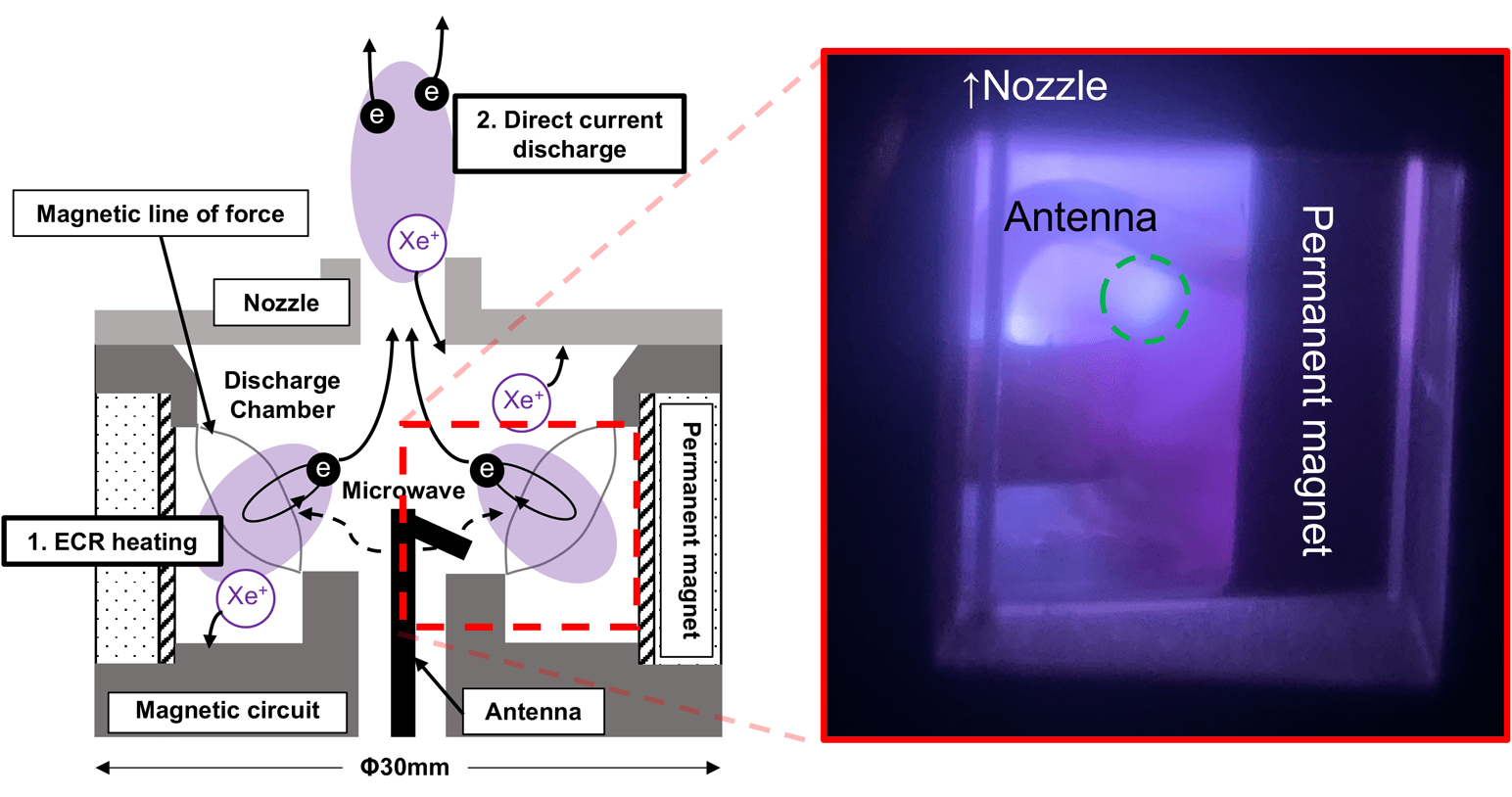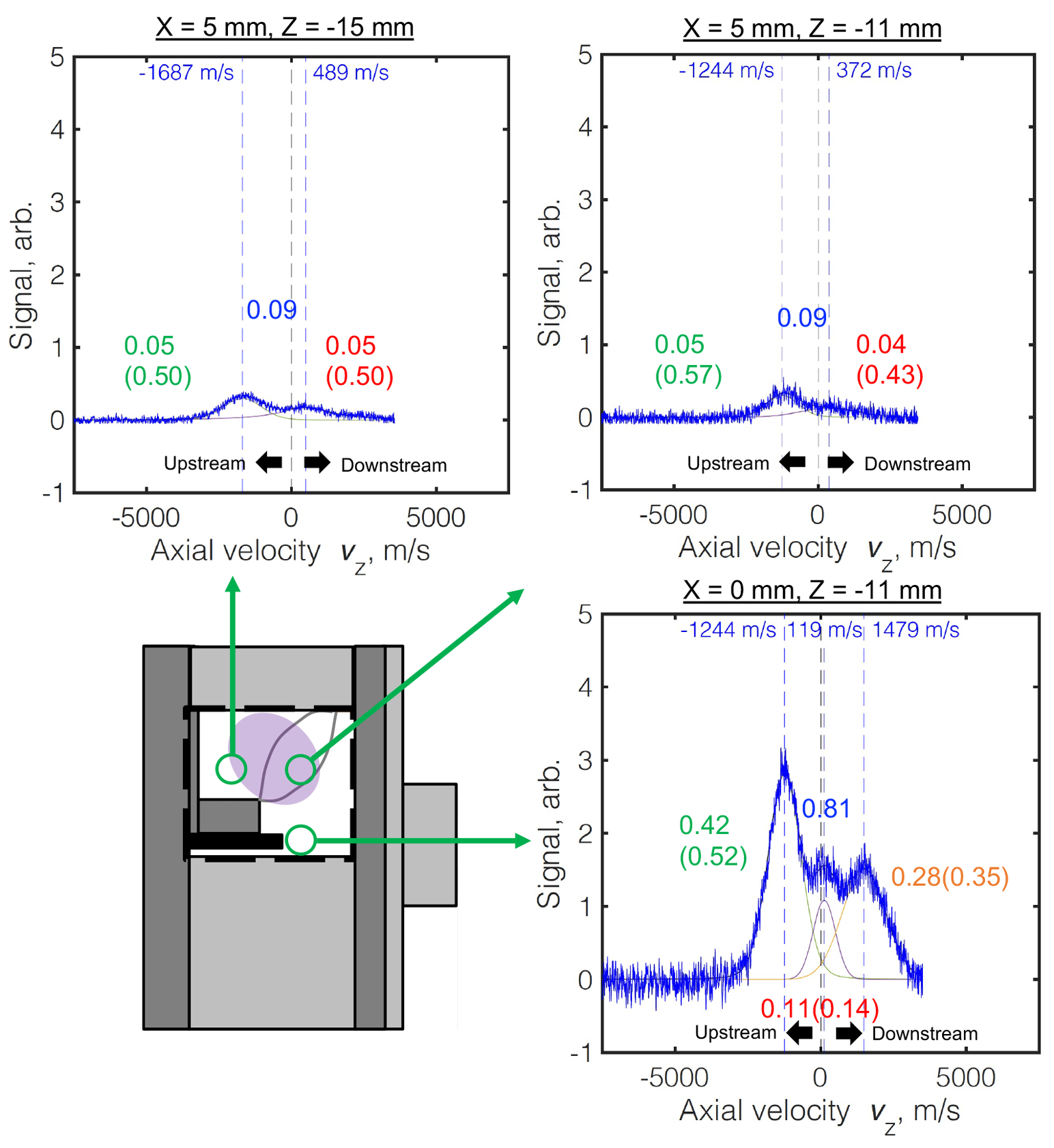Succeeded in observing the internal plasma of the ion thruster neutralizer
Apr. 13, 2023 | GATEWAY to Academic Articles
There are mainly two types of spacecraft propulsion: chemical propulsion and electric propulsion. In the case of chemical propulsion, the nozzle converts propellant at high temperature and high pressure into thrust. The exhaust velocity is an order of magnitude lower than that of electric propulsion, but the thrust density (thrust per unit area) is large due to the large propellant mass. Therefore, it is suitable for launch rockets that require large thrust density and attitude control for quick response. On the other hand, electric propulsion has a low thrust density due to its small exhaust mass, but has a large specific impulse (thrust per to unit propellant)*1. The propellant is a charged plasma*2 that is directly affected by electromagnetic and electrostatic forces which are used to accelerate the plasma to generate thrust to move the spacecraft. Due to the low thrust density but high fuel efficiency, electric propulsion is suitable for deep space exploration.
An ion thruster is one of the forms of electric propulsion and consists of two major components, namely an ion source and a neutralizer cathode. Ions from the ion source are accelerated by a system consisting of several grids and form an ion beam. The cathode emits electrons at the same rate as that at which the ions are accelerated to avoid an electrostatic charge imbalance between the spacecraft and the space plasma. Our laboratory previously developed a microwave discharge cathode as the neutralizer cathode of the microwave gridded ion thruster μ10, which was the main propulsion system for the asteroid sample return mission Hayabusa and its successor Hayabusa2. In addition, it is planned to be used in the comet fly-by mission DESTINY+. Prior to the first mission, μ10 completed a 20 000-h lifetime endurance test at a ground facility. Although the mission was a success, it was observed that the microwave neutralizer cathode ofμ10 degraded faster than it did in the ground endurance test. Therefore, it is necessary to clarify the deterioration mechanism and extend the lifetime. To tackle this kind of problem, a mechanism had to be developed to observe what was happening inside the cathode.
An understanding of the plasma physics inside a microwave discharge cathode is key to extending the lifetime of microwave ion thruster systems. Therefore, we performed optical diagnostics of a visualizable microwave discharge cathode with the same performance as the flight model. By the optical diagnostics, we measured the energy, density, and flow field of ions parametrically. As a result, we could obtain important knowledge to help reveal the deterioration mechanism.
Research Summary

Figure 1(left) shows a schematic diagram of a microwave discharge cathode. The cathode consists of permanent magnets, magnetic circuits, a discharge chamber, an antenna, and a nozzle. As shown in the figure, electrons are generated via two methods. In the first electron generation method, collisions between neutral particles and high-energy electrons heated by ECR*3 are used. In the second electron generation method, called direct current discharge, the potential difference drives the electrostatic acceleration of electrons from the cathode plasma to the ion beam. The acceleration is sufficient to drive the electron impact ionization of neutrals and produces electrons for ion beam neutralization. As an important characteristic, it has long lifetime in principle, because it is heater-less cathode.
To determine the operation and degradation mechanisms of the microwave discharge cathode, it is important to clarify the plasma parameters both in the direct current discharge region and inside the cathode. However, the parameters inside the microwave discharge cathode have not been well investigated. It is difficult to experimentally measure the plasma parameters inside the cathode using mechanical probes without significantly affecting the performance due to microwave electric field disturbance. To overcome these problems, optical measurements are conducted in this research.
However, by the optical approach, it is also difficult to measure plasma parameters inside a cathode without affecting its performance. Because optical windows are insulators, they interfere with the absorption of ions, which are the emitted electron counterparts. Optical windows thus degrade the cathode performance. To investigate the actual conditions of the Hayabusa2 onboard cathode, we needed to develop a microwave discharge cathode with an optical window that has equivalent characteristics to those of the flight model. By conducting a careful study of the microwave power, electron current and flow of ions, we located a position for an optical window where the effect on the plasma would be minimized. Therefore, we succeeded in making optical observations inside a cathode with a performance equivalent to that of the flight model.
As shown in Figure 1(right), a high intensity region was observed especially at the bent inner root of the antenna and at the edge of magnetic circuit (see green circle). This region is important to evaluate the cathode lifetime.

In addition, we measured ion density and velocity distribution*4 by laser-induced fluorescence spectroscopy.*5
As shown in Figure 2, multimodal (multiple peaks in the range of velocities*6) characteristics were confirmed in the cathode. However, peak velocity and intensity ratio were same for all values of parameters.
Therefore, we investigated the relationship between the ion acoustic wave*7 and the multimodal characteristics. As a result, the ion oscillation*7 model well matched the measured multimodal characteristics.
The development of a microwave discharge cathode with a small optical window for visual observations can provide important knowledge to clarify problems such as the deterioration mechanism and improve the thruster performance for future explorations.
Terminologies
- *1 Specific impulse:Ratio of the thrust produced to the weight flow of the propellants.
- *2 Plasma:One of four fundamental states of matter consisting of ions and electrons.
- *3 Electron cyclotron resonance, ECR:Resonance phenomenon due to electromagnetic wave and Lorentz frequency.
- *4 Velocity distribution:Distribution that shows how much particles with a certain velocity.
- *5 Laser-induced fluorescence, LIF:Spontaneous emission resulted from the resonant absorption of the laser radiation by ions.
- *6 Multimodal:Characteristic of multiple peaks in a signal waveform. In this study, the ion velocity distributions have some peaks.
- *7 Ion acoustic wave and oscillation:Longitudinal oscillation of the ions and electrons in a plasm.
Information
| Journal Title | Journal of Applied Physics (American Institute of Physics) |
|---|---|
| Full title of the paper | Plasma parameters measured inside and outside a microwave-discharge-based plasma cathode using laser-induced fluorescence spectroscopy |
| DOI/URL | Paper: https://doi.org/10.1063/5.0071294 Scilight (Science highlight): https://aip.scitation.org/doi/10.1063/10.0009218 |
| Publish date | 03 January 2022 |
| Author(s) | Takato Morishita, Ryudo Tsukizaki, Kazutaka Nishiyama, and Hitoshi Kuninaka |
| ISAS or JAXA member(s) among author(s) | MORISHITA Takato (Dept.of Aeronautics and Astronautics,The University of Tokyo), TSUKIZAKI Ryudo (ISAS), NISHIYAMA Kazutaka (ISAS), and KUNINAKA Hitoshi(ISAS) |
Links
- MORISHITA Takato (researchmap)
- Asteroid Explorer Hayabusa2
- Deep Space Exploration Technology Demonstrator DESTINY+


 MORISHITA Takato / Research, Test and Operation Technology Group, ISAS
MORISHITA Takato / Research, Test and Operation Technology Group, ISAS